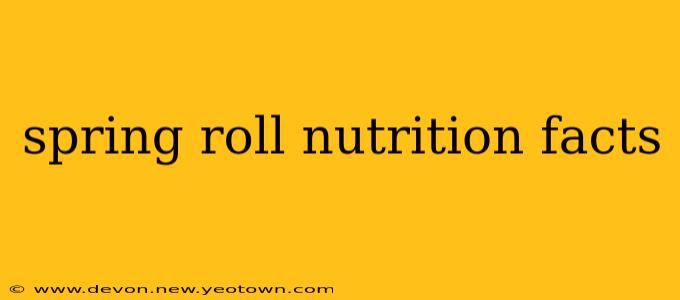Spring rolls! The vibrant, colorful, and often delicious snack that pops up everywhere from bustling street markets to elegant restaurants. But beyond their appealing appearance, what's the nutritional story behind these culinary delights? Let's unravel the facts, exploring the nutritional value and addressing some common questions surrounding this popular food.
My journey into the world of spring roll nutrition started with a simple question: "Are spring rolls healthy?" The answer, as with most things, is a resounding "it depends." The nutritional profile of a spring roll varies dramatically depending on its ingredients. A spring roll brimming with fresh vegetables offers a vastly different nutritional profile compared to one filled with deep-fried meats and creamy sauces.
What are the main ingredients in a spring roll and how do they affect the nutritional value?
The foundation of a spring roll is its wrapper – typically rice paper or wheat-based wrappers. Rice paper wrappers are generally lower in calories and carbohydrates than wheat wrappers. The fillings are where the real nutritional variation comes in. Fresh vegetables like lettuce, carrots, cucumbers, and bean sprouts contribute vitamins, minerals, and fiber. Lean proteins such as shrimp, chicken, or tofu offer protein and essential amino acids. However, the addition of processed meats, rich sauces, and deep-frying significantly increases the fat, sodium, and calorie content.
Are spring rolls high in calories?
This is a question I frequently hear. The calorie count of a spring roll is highly variable. A single fresh spring roll packed with vegetables can contain as few as 50-75 calories. However, a larger, fried spring roll laden with meat and sauce can easily exceed 300-400 calories. Therefore, the calorie content is heavily influenced by the ingredients and preparation method.
How much protein, fat, and carbohydrates are in a spring roll?
The protein, fat, and carbohydrate content of spring rolls depend entirely on the ingredients. Vegetable-based spring rolls are naturally lower in fat and higher in carbohydrates, predominantly from the wrapper and vegetables. The addition of protein sources like tofu or chicken increases the protein content. Fried spring rolls, with their added oil, will have a significantly higher fat content, often exceeding the amount of carbohydrates. The specific macronutrient breakdown will always depend on the recipe.
Are spring rolls a good source of vitamins and minerals?
Yes, especially when filled with fresh vegetables. Spring rolls offer a good source of vitamins A, C, and K, as well as minerals like iron and potassium – particularly when using a variety of colorful vegetables. However, the nutritional benefits are diminished if the rolls are heavily processed or fried, as these processes can reduce the vitamin and mineral content.
What are the benefits of eating spring rolls?
When made with fresh, healthy ingredients, spring rolls offer several health benefits. They can be a good source of essential vitamins and minerals, provide fiber for healthy digestion, and offer a lighter, refreshing meal or snack option compared to heavier, fried foods.
Are there any downsides to eating spring rolls?
The downsides primarily relate to the preparation methods and ingredients used. Fried spring rolls are high in unhealthy fats and calories. Spring rolls with processed meats or excessive sauces are also high in sodium and unhealthy fats. Therefore, choosing fresh, vegetable-rich spring rolls and avoiding fried options are crucial for maximizing the nutritional benefits.
In conclusion, the nutritional value of spring rolls is a spectrum. They can be a nutritious and delicious snack or meal, providing vitamins, minerals, and fiber, or they can be a high-calorie, unhealthy indulgence depending on the ingredients and preparation method. The key is to be mindful of what goes into your spring roll and opt for fresh, healthy ingredients whenever possible. Enjoy responsibly!

